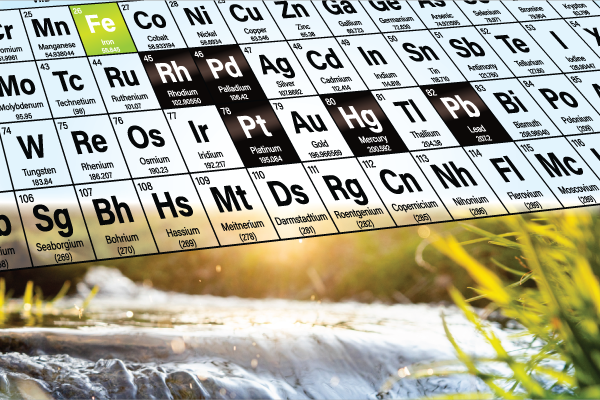April 18, 2024
by Baljit Bains, Marketing Communications Specialist, ACD/Labs
The Role of High Throughput Experimentation (HTE) in Green Synthesis
Sustainability is a growing concern in all aspects of life. Whether it is carbon emissions, plastic pollution, or deforestation, there is an endless list of environmental problems. While everyone should be mindful of their ecological footprint, scientists have a unique role in finding solutions through research and developing sustainable industrial processes.
One area where chemists can have a profound impact is the selection of catalysts. Heavy metals, such as palladium, platinum, and rhodium, are efficient catalysts that have been used in a variety of applications for decades (or centuries). Unfortunately, they are carbon-intensive to produce and are hazardous to the environment. There has been an effort to switch to non-heavy metal catalysts such as nickel and iron, though these substitutes are sometimes less sustainable given the large quantities that must be used (learn more in C&EN).
This leads to an important question: how can chemists select catalysts to support environmentally responsible synthetic methods?
We asked Edward Milton-Harris, a Senior Application Scientist at ACD/Labs. Previously, he researched non-heavy metal catalysts at Pfizer and investigated palladium and platinum cross-coupling reactions for his PhD.

Catalysts are a minor ingredient in chemical reactions in terms of total volume. Why is there concern about the environmental impact of heavy metal catalysts?
They’re used in tiny amounts, but that’s because they’re so active. If any metal is left over, it can still catalyze reactions and do funny things in water tables and soil. Heavy metals can have a serious impact not only on the environment but also on patients. When you work in pharmaceutical research, you’ve got to make sure that all the heavy metals are removed at the end of your chemical synthesis before a drug can be sold.
This leads to purification challenges since you need to ensure no catalyst is left over. You also have to be careful to monitor those metals throughout the entire lifecycle of a drug product.
Some research teams are switching to non-heavy metal catalysts such as nickel or iron to reduce environmental impact. What are the advantages and disadvantages of this move?
For advantages, they’re easier to handle, they’re easier to synthesize in the lab, and they are usually less toxic. We have iron in our blood, so it is fairly safe, though catalysts also include ligands, which may change their safety. Iron would be an ideal candidate because it’s the safest alternative to heavy metals such as palladium, platinum, and rhodium. However, iron is limited in terms of the chemical transformations it can facilitate.
On the other hand, these metals are much less active than their palladium or platinum counterparts. You need significantly more of that material to do the same job. You’re probably using ten times the amount of material for an iron catalyst versus a palladium catalyst. It’s going to be a huge cleanup job at the end of the chemical synthesis or drug manufacturing process. You must ensure it’s controlled to prevent contamination of any water or soil.
Purifying these catalysts is usually easier. They’re more water-soluble than their palladium counterparts, so you can flush them out and wash them away using organic workups with acids and bases. However, you still must control those waste materials at the end of the process.
In that case, how do you minimize the environmental impact of your reactions? Heavy metals are more dangerous but can be used in small quantities, while metals like iron and nickel are less harmful but must be used in larger volumes.
You can look for alternatives. We’re not limited to doing things in round bottom flasks anymore. Technology like HTE allows you to work on a much smaller scale and get results quickly. In my experience, a catalyst optimization screen can take weeks if you do it one by one in test tubes or round bottom flasks. With an HTE approach, you can use a robot with a 96-well plate, and it will distribute your materials, run your synthesis, and analyze the results in a day or less.
HTE also allows you to get a lot of information out with minimal material. If you imagine you’ve got an intermediate as part of your drug campaign, you don’t want to burn that in the space of a week and spend another six months making it. You want to get the most out of what you have; working at a smaller volume allows that.
HTE helps you find greener methods and generates less waste along the way. You’re using much less solvent, starting material, catalysts, and so on. It’s an excellent alternative.
What are some of the components of a successful HTE initiative?
That’s a tricky one because everybody does things slightly differently. The end goal is always the same—you’re trying to get fast, accurate results for your optimizations or your library synthesis. Whatever workflow you’ve got in the lab, you need to get those results as quickly and as accurately as you can.
Katalyst D2D helps you design your experiments and optimize them along the way. Scientists often have their data scattered in Excel, Word, PowerPoint, and different instrument vendor software. It’s a nightmare to collate all that information together. With Katalyst D2D, you can collate that information into a single platform. Instead of having to look at your instrument, LCMS software, design software, peak results, and graphs in Excel, you’ve got everything in one place. Katalyst D2D can also sweep your data, process it uniformly, and bring results into an intuitive platform.
Another critical aspect is reporting the unsuccessful reactions, which is important later in the research and development process. If you’re working on a tiny scale with a few milligrams on a plate array, it must be scalable to a pilot plant using a few kilos or tons. Results from unsuccessful reactions will help you avoid unnecessary work at the scale-up stage, which supports better efficiency and scalability.
